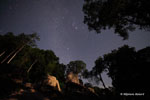HOME
Tikal (Petén, Guatemala) - A Major Mayan city
and UNESCO world heritage site

© Stéphane Guisard, Los Cielos de Los Mayas
Credit: Stéphane Guisard / IDAEH-Tikal
Tikal (or Tik'al according to the modern Mayan orthography) is one of the largest archaeological sites and urban centres of the pre-Columbian Maya civilization. It is located in the archaeological region of the Petén Basin in what is now northern Guatemala. Situated in the department of El Petén, the site is part of Guatemala's Tikal National Park and in 1979 it was declared a UNESCO World Heritage Site.
Tikal was the capital of a conquest state that became one of the most powerful kingdoms of the ancient Maya. Though monumental architecture at the site dates back as far as the 4th century BC, Tikal reached its apogee during the Classic Period, ca. 200 to 900 AD. During this time, the city dominated much of the Maya region politically, economically, and militarily, while interacting with areas throughout Mesoamerica such as the great metropolis of Teotihuacan in the distant Valley of Mexico. There is evidence that Tikal was conquered by Teotihuacan in the 4th century AD. Following the end of the Late Classic Period, no new major monuments were built at Tikal and there is evidence that elite palaces were burned. These events were coupled with a gradual population decline, culminating with the site's abandonment by the end of the 10th century. Tikal is the best understood of any of the large lowland Maya cities, with a long dynastic ruler list, the discovery of the tombs of many of the rulers on this list and the investigation of their monuments, temples and palaces. Text above taken from Wikipedia.
Deseo expresar mis mas profundos agradecimientos al Ministro de Cultura de Guatemala, al INGUAT, al IDAEH y Parque Nacional Tikal por haber hecho posible este trabajo. Agradezco también sinceramente a Adriana, Federico, Fredy y Victor por su ayuda en la preparación y el buen desarrollo de este proyecto.





Temple I (Templo del Gran Jaguar) and Orion constellation.
Temple I (also known as the Temple of Ah Cacao or Temple of the Great Jaguar) is a funerary pyramid dedicated to Jasaw Chan K'awil, who was entombed in the structure in AD 734, the pyramid was completed around 740–750.The temple rises 47 metres (154 ft) high. The massive roofcomb that topped the temple was originally decorated with a giant sculpture of the enthroned king, although little of this decoration survives. The tomb of the king was discovered by Aubrey Trik of the University of Pennsylvania in 1962. Among items recovered from the Late Classic tomb were a large collection of inscribed human and animal bone tubes and strips with sophisticated scenes depicting deities and people, finely carved and rubbed with vermilion, as well as jade and shell ornaments and ceramic vessels filled with offerings of food and drink.The shrine at the summit of the pyramid has three chambers, each behind the next, with the doorways spanned by wooden lintels fashioned from multiple beams. The outermost lintel is plain but the two inner lintels were carved, some of the beams were removed in the 19th century and their location is unknown, while others were taken to museums in Europe.

Temple I (Templo del Gran Jaguar) Canis Major constellation and stone stela.
Stelae are carved stone shafts, often sculpted with figures and hieroglyphs.

Northern Pole rotation above Temple I (Templo del Gran Jaguar) and Temple II ("Templo de las Máscaras" or "Templo de la Luna")
Temple II (also known as the Temple of the Mask) in was built around AD 700 and stands 38 metres (125 ft) high.
Like other major temples at Tikal, the summit shrine had three consecutive chambers with the doorways spanned by wooden lintels,
only the middle of which was carved. The temple was dedicated to the wife of Jasaw Chan K'awil, although no tomb was found.
The queen's portrait was carved into the lintel spanning the doorway of the summit shrine. One of the beams from this lintel
is now in the American Museum of Natural History in New York.

The 7 Temples and Orion constellation.
The Plaza of the Seven Temples is to the west of the South Acropolis. It is bordered on the east side by a row of nearly identical temples, by palaces on the south and west sides and by an unusual triple ballcourt on the north side.

Orion constellation above Temple V.
Temple V stands south of the Central Acropolis and is the mortuary pyramid of an as yet unidentified ruler.
The temple stands 57 metres (187 ft) high, making it the second tallest structure at Tikal - only Temple IV is taller.
The temple has been dated to about AD 700, in the Late Classic period, via radiocarbon analysis and the dating of ceramics
associated with the structure places its construction during the reign of Nun Bak Chak in the second half of the 7th century.
Orion constellation above Mundo Perdido Temple.
The Lost World Pyramid (Structure 5C-54) lies in the southwest portion of Tikal’s central core, south of Temple III and west of Temple V.
It was decorated with stucco masks of the sun god and dates to the Late Preclassic; this pyramid is part of an enclosed complex of structures
that remained intact and un-impacted by later building activity at Tikal. By the end of the Late Preclassic this pyramid was one of the largest structures in the Maya region.
It attained its final form during the reign of Chak Tok Ich'aak in the 4th century AD, in the Early Classic, standing more than 30 metres (98 ft) high with stairways on all
four sides and a flat top that possibly supported a superstructure built from perishable materials.Although the plaza later suffered significant alteration,
the organization of a group of temples on the east side of this complex adheres to the layout that defines the so-called E-Groups, identified as solar observatories.
Orion constellation above Mundo Perdido Temple.
